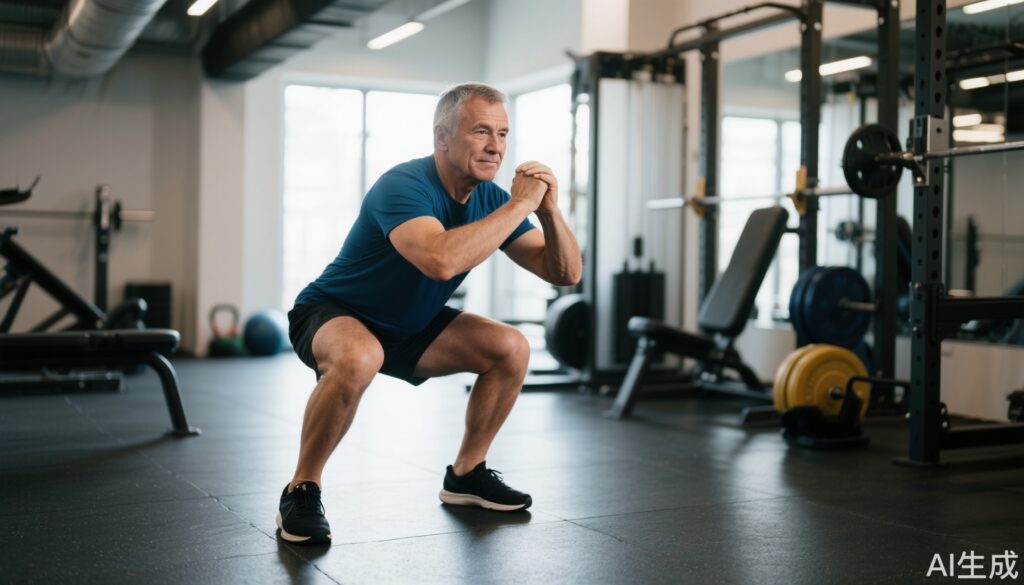Introduction
Squats are a staple in fitness routines, often praised for their ability to enhance lower body strength and overall physical fitness. But did you know they might also have a profound impact on male sexual health? This article delves into the science behind how squats can improve sexual function, offering a structured plan for individuals at different fitness levels.
Scientific and Clinical Evidence
Promoting Blood Circulation
One of the most significant benefits of squats is their ability to enhance blood circulation. During squats, the muscles in the lower body contract and relax rhythmically, promoting efficient blood flow throughout the body. Crucially, this increased circulation can direct more blood to the reproductive organs, ensuring they receive ample oxygen and nutrients. This process is vital for maintaining the health and function of these organs, potentially leading to improved sexual performance.
Boosting Hormone Production
Squats are a form of compound strength training, meaning they involve multiple muscle groups working simultaneously. This type of exercise is known to stimulate the production of hormones like testosterone, which plays a crucial role in male sexual function, libido, and reproductive health. Higher levels of testosterone can enhance sexual drive and performance in men, and even contribute positively to sexual health in women.
Strengthening Pelvic Floor Muscles
Another often-overlooked benefit of squats is the strengthening of pelvic floor muscles. These muscles are integral to controlling ejaculation and erectile function, thus playing a significant role in sexual health. Strong pelvic floor muscles can lead to better control during intercourse and enhance overall sexual satisfaction.
Different Stages of Squat Routine
Beginner Stage (Weeks 1-2)
For individuals new to squatting, it is crucial to allow the body time to adapt. Start with three sets of squats daily, with each set comprising 10-15 repetitions. This stage focuses on mastering the correct squat technique, ensuring body balance and stability to prevent injury.
Intermediate Stage (Weeks 3-4)
Once the initial phase is complete and the body is accustomed to squats, it’s time to increase both the volume and intensity. Aim for four sets daily, with each set consisting of 15-20 repetitions. Introducing additional weights, like dumbbells, can further stimulate muscle growth and strength. Adjust the weight based on personal capacity to avoid overexertion.
Advanced Stage (Week 5 and Beyond)
After building a solid foundation, increase the workout intensity by performing five sets of squats daily, with each set having 20-25 repetitions. Gradually increase the weight to continue challenging the muscles. However, ensure proper rest periods and avoid overtraining to prevent fatigue and injury.
Important Considerations
Correct Posture
Maintaining proper form is critical to maximizing benefits and minimizing injury risk. Stand with feet shoulder-width apart, toes slightly pointing outward, and keep the back straight. Ensure knees do not extend past toes during the squat. Improper posture can lead to injuries, particularly in the knees and lower back.
Gradual Progression
Avoid the temptation to rush the process. Gradually increase the number and intensity of squats to allow the body to adapt and prevent injuries. Progress should be tailored to individual fitness levels and capabilities.
Rest and Recovery
Allow the body sufficient time to recover post-exercise. Allocate at least 1-2 rest days per week for muscle repair and relaxation. Incorporating stretching exercises post-workout can help alleviate muscle tension and fatigue.
Conclusion
Squats present a scientifically-backed, effective method for enhancing sexual health, provided they are incorporated into a well-planned routine. Understanding the underlying principles, adhering to a structured exercise plan, and prioritizing correct posture and recovery are key to optimizing the benefits safely. As with any exercise regimen, listen to your body and consult a professional if pain or discomfort occurs.
References
1. Kraemer, W.J., et al. (2008). Effects of resistance training on testosterone levels in men. Journal of Strength and Conditioning Research.
2. McArdle, W.D., Katch, F.I., & Katch, V.L. (2010). Exercise Physiology: Nutrition, Energy, and Human Performance.
3. American College of Sports Medicine. (2013). ACSM’s Guidelines for Exercise Testing and Prescription.



